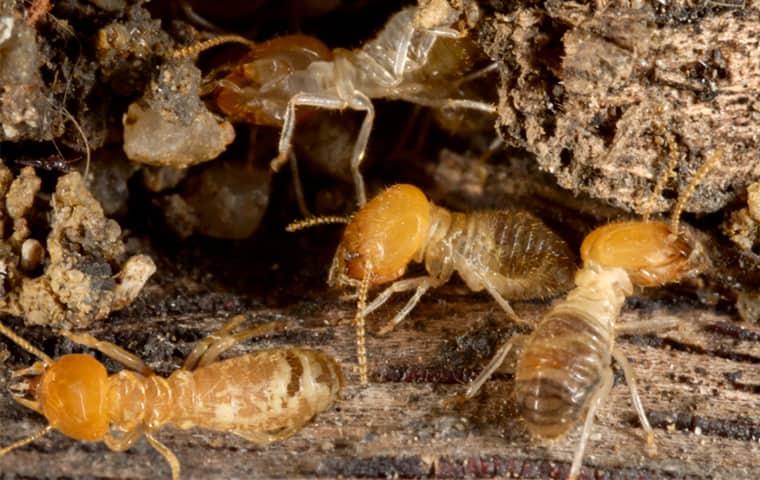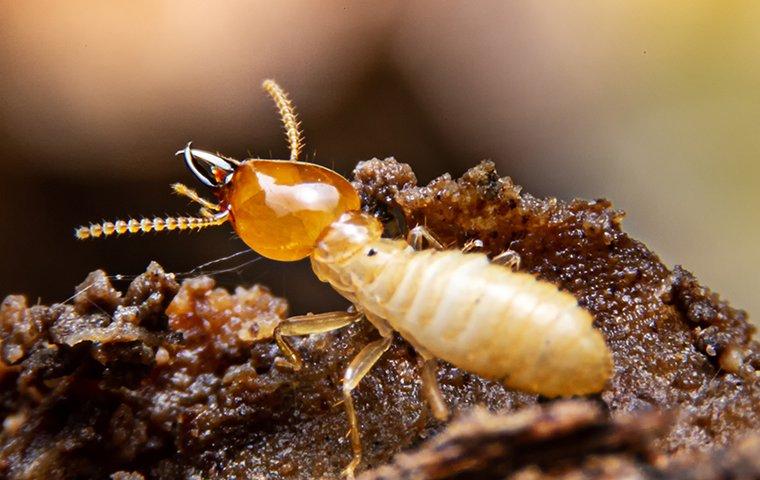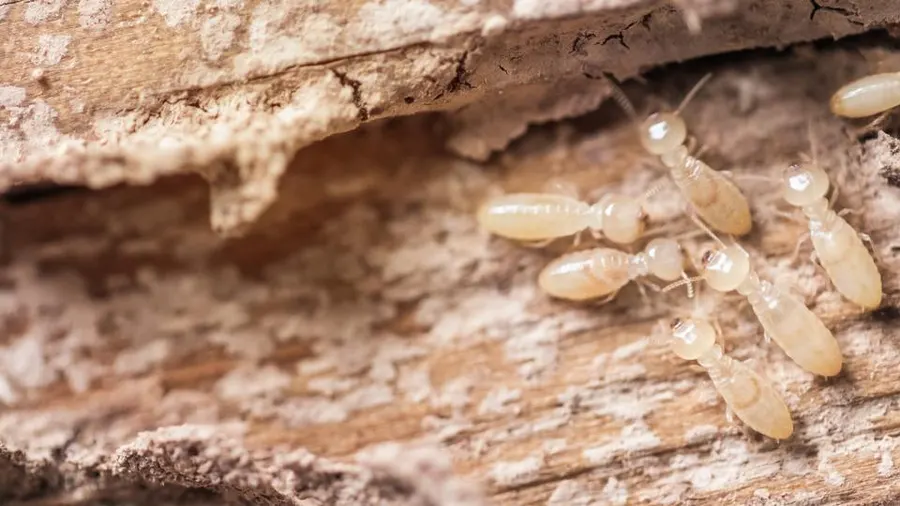Yes, termites can eat Drywall because it contains cellulose, a substance they feed on. Termites may damage Drywall in search of food and moisture, potentially causing structural problems.
Here are some hidden facts regarding the termite and the Drywall.
- Termites can tunnel through and consume drywall material.
- Damaged Drywall can be a sign of a termite infestation.
- Moisture present in Drywall can also attract termites.
- Regular inspections can help detect termite activity in Drywall.
The composition of the Drywall and the termite’s feeding behavior will explore the termite’s attraction to the Drywall. So, let’s continue reading to know the composition between Drywall and termite’s feeding behavior.
The Composition of Drywall and Termites’ Feeding Behavior

A. Drywall and its components
Drywall, also called gypsum board or sheetrock, is a common interior building material with three main components.
Gypsum: The core of Drywall consists of gypsum, a mineral composed of calcium sulfate. Gypsum provides structural integrity and fire-resistant properties to Drywall.
Paper Facing: Drywall sheets are covered on both sides with paper facing.
The paper-facing shields the gypsum core and makes a smooth surface for painting or wallpaper.
Additives: Various additives, such as fire retardants and mold inhibitors, may enhance its performance in drywall production.
B. Termites’ eating habits related to Drywall
Termites are known for eating things made of cellulose, like wood, paper, and plant fibers. However, termites exhibit a somewhat selective feeding behavior when it comes to Drywall.
Paper Facing: Termites are attracted to the paper facing of Drywall due to its cellulose content. They will often chew through the paper to access the inner gypsum core.
Gypsum Core: While termites can eat Drywall’s paper covering, they do not gain significant nutritional value from the gypsum core. Gypsum lacks the cellulose content necessary for termites’ sustenance.
Moisture Requirement: Termites require moisture to aid in the digestion of cellulose. Drywall, a relatively dry material, is less appealing to termites than damp wood or other cellulose-rich sources.
C. How do termites digest cellulose found in Drywall?
Termites possess a unique ability to digest cellulose with the help of specialized microorganisms living in their gut. Here’s a simplified explanation of this process:
Ingestion: Termites consume cellulose from materials like Drywall by chewing and breaking it down into smaller particles.
Microbial Fermentation: The termites’ gut contains a community of microorganisms, including bacteria and protozoa, which help break down cellulose into simpler sugars through fermentation.
Absorption: Termites absorb the digested sugars and nutrients from the gut, providing them with energy and sustenance.
In summary, while termites are attracted to the cellulose in the paper facing of Drywall, they do not consume the gypsum core.
Additionally, their ability to digest cellulose relies on a symbiotic relationship with gut microorganisms, which is why they primarily target materials with higher cellulose content than Drywall.
Signs of Termite Infestation in Drywall
A. Identifying the warning signs of termites in Drywall
To deal with termites and Drywall, it’s vital to spot early signs of an infestation. These signs include:
Mud Tubes: Termites often create mud tubes along the surface of walls. These small, tunnel-like structures protect them from light and predators as they travel between their nest and their food source, which could be Drywall.
Frass: Termite droppings, known as “frass,” may accumulate near infested areas. Frass resembles small wood pellets and is a sign of termite activity.
B. Common indicators, such as mud tubes, frass, and hollow-sounding walls
Mud Tubes: Look for narrow, pencil-sized tubes along walls, especially near the ground. If you break open a mud tube and termites are inside, it’s a clear sign of infestation.
Frass: Keep an eye out for small piles of frass near walls or furniture. If you notice this accumulation, it’s a strong indicator that termites are present.
Hollow-Sounding Walls: Tap on your Drywall. If it sounds hollow or papery, it could be a sign that termites have eaten the cellulose within, leaving the gypsum core hollow.
C. Importance of early detection and prevention
Early detection of termite infestations is crucial to prevent extensive damage to your Drywall and property. Termites can silently and quickly weaken the structural integrity of drywalls and other wooden structures.
Regular inspections and vigilance are key to catching infestations before they become severe.
Preventing and Treating Termite Infestations in Drywall
A. Tips for termite prevention in residential and commercial spaces
Moisture Control: Termites thrive in damp environments, so address any leaks or moisture issues in and around your property.
Remove Wood-to-Soil Contact: Ensure that wooden structures do not make direct contact with the soil, as this can provide easy access for termites.
Regular Inspections: Conduct routine inspections for signs of termites, especially in areas with Drywall or other cellulose-based materials.
B. Different treatment options, including chemical and non-chemical methods
Chemical Treatments: Professional pest control services often use chemical treatments to eliminate termites. These chemicals may be applied to the soil around your property or directly to affected areas.
Non-Chemical Methods: Non-chemical options include using baits or installing physical barriers like termite shields to prevent termites from entering your property.
In conclusion, being vigilant about the signs of termite infestation in Drywall, taking preventive measures, and seeking professional assistance when needed are essential steps to protect your property from termite damage.
Spotting issues early and taking action can prevent expensive repairs and maintain your Drywall and structural strength.
Ensuring the Structural Integrity of Drywall
A. Maintenance practices to prevent termite damage to Drywall
To safeguard your Drywall from potential termite damage, you can follow these maintenance practices:
Sealing and Painting: Seal any cracks or gaps in the Drywall and apply a fresh coat of paint. This helps create a barrier that can deter termites from accessing the cellulose-rich paper facing.
Keep Drywall Dry: Ensure that your Drywall remains dry by promptly addressing any leaks or moisture issues. Termites are less attracted to dry environments.
Trim Vegetation: Trim bushes, trees, and shrubs away from your walls to reduce the risk of termites using them as a bridge to reach the Drywall.
B. Importance of regular inspections and repairs
Regular inspections and timely repairs are crucial to maintain drywall integrity:
Visual Inspections: Periodically inspect your Drywall, especially in areas prone to moisture or where you suspect termite activity. Look for signs like mud tubes, frass, or hollow-sounding walls.
Prompt Repairs: If you notice any damage or signs of termite infestation, address it immediately. Repair or replace affected drywall sections to prevent further structural issues.
Professional Inspection: Consider scheduling professional termite inspections annually or as pest control experts recommend. They can identify hidden infestations and offer advice on preventive measures.
C. Alternative building materials to consider for termite-prone areas

In areas with a high risk of termite infestations, you might want to change your Drywall with alternative building materials that are less attractive to termites:
Steel Framing:
- Steel framing is a highly effective termite-resistant option. Termites cannot feed on steel, which eliminates the risk of infestation.
- Steel framing typically costs between $5 and $10 per square foot of construction, making it a competitive choice in terms of both termite resistance and cost efficiency.
Concrete Block or Masonry:
- Concrete block walls and masonry construction are well-documented for their termite resistance. Their lack of cellulose content makes them unattractive to termites.
- While initial construction costs for masonry can be higher, the long-term durability and termite resistance make it a cost-effective choice over time.
Fiber Cement Siding:
- Fiber cement siding contains cement, sand, and cellulose fibers. The cement makes it unattractive to termites despite containing cellulose.
- Fiber cement siding typically costs between $4 and $9 per square foot, balancing termite resistance and affordability.
Metal Cladding:
- Metal siding and cladding materials like aluminum or steel are entirely impervious to termites, providing robust protection.
- Depending on the metal type, metal cladding costs between $4 and $12 per square foot, offering a durable and cost-effective choice.
Plastic and Composite Materials:
- Some plastic and composite building materials, such as PVC trim boards and composite decking, are termite-resistant due to their composition.
- Prices for these materials vary but often fall within the range of traditional wood alternatives, making them competitive options.
Pressure-Treated Wood:
- Pressure-treated wood is infused with chemicals that deter termites and other pests, protecting against infestations.
- The cost of pressure-treated lumber is typically higher than untreated wood, but it remains an economical choice for termite prevention, with prices varying based on wood type and treatment level.
Termite Barriers:
- Physical termite barriers, such as metal termite shields or termite mesh, create a protective layer between soil and the building’s foundation, preventing termite access.
- Installation costs for termite barriers depend on the size and complexity of the structure but are generally reasonable compared to potential termite-related repair expenses.
In conclusion, choosing termite-resistant building materials in termite-prone areas is a wise investment in property protection.
While initial costs may vary, the long-term savings from avoiding termite damage and treatments can be substantial. Additionally, the peace of mind that comes with reduced termite risk is invaluable for homeowners and builders alike.
FAQs
How can I tell if termites are eating my Drywall?
Look for blistering or bubbling paint, pinholes, or hollow-sounding walls, as these can be signs of termite damage to Drywall.
Is all Drywall equally attractive to termites?
No, not all Drywalls are equally attractive to termites; paper-faced Drywall, due to its cellulose content, is typically more appealing to them.
Can termites eat through painted Drywall?
Yes, termites can eat through painted Drywall, as the paint does not deter them from accessing the cellulose within.
Can termites eat through the plasterboard or gypsum board?
Yes, termites can eat gypsum board, but they may prefer materials with higher cellulose content, like paper-faced Drywall.
Will termites eat through insulation behind Drywall?
Termites can tunnel through insulation materials, including those behind Drywall, to access wooden structures.
How can I prevent termites from damaging my Drywall?
Implement termite prevention measures like regular inspections, maintaining proper ventilation, and addressing moisture issues to reduce the risk of drywall damage.
Can termites eat through concrete walls to reach Drywall?
No, Termites cannot eat through concrete walls to reach Drywall, but they can create mud tunnels on the surface to reach Drywall or other cellulose-rich materials.
Is it common for termites to target Drywall in homes?
Termites are more likely to target wooden structures, but if the Drywall has cellulose content, it can be damaged if termites are present and hungry for food sources.
Conclusion
In conclusion, termites eat Drywall, as it is a common food source for termites as it provides them with cellulose, their primary nutrient.
If left untreated, termite infestations can cause significant damage to the structural integrity of buildings, including Drywall.
Therefore, it is essential to monitor for termite activity and take appropriate measures to eliminate and prevent infestations to protect the integrity of Drywall and the overall structure.

